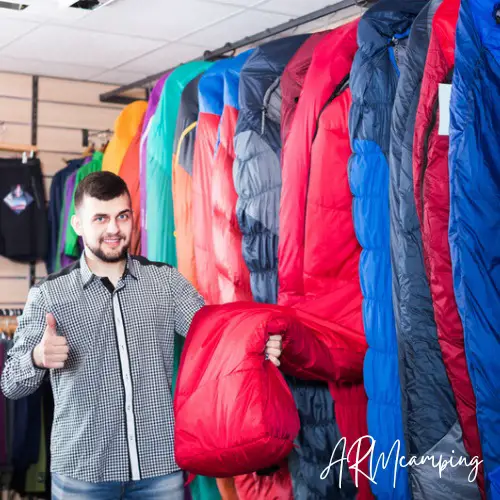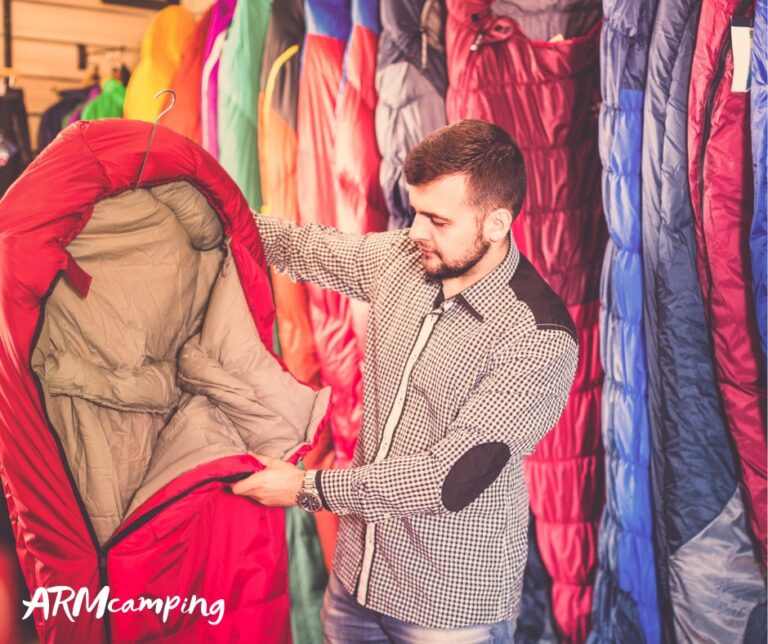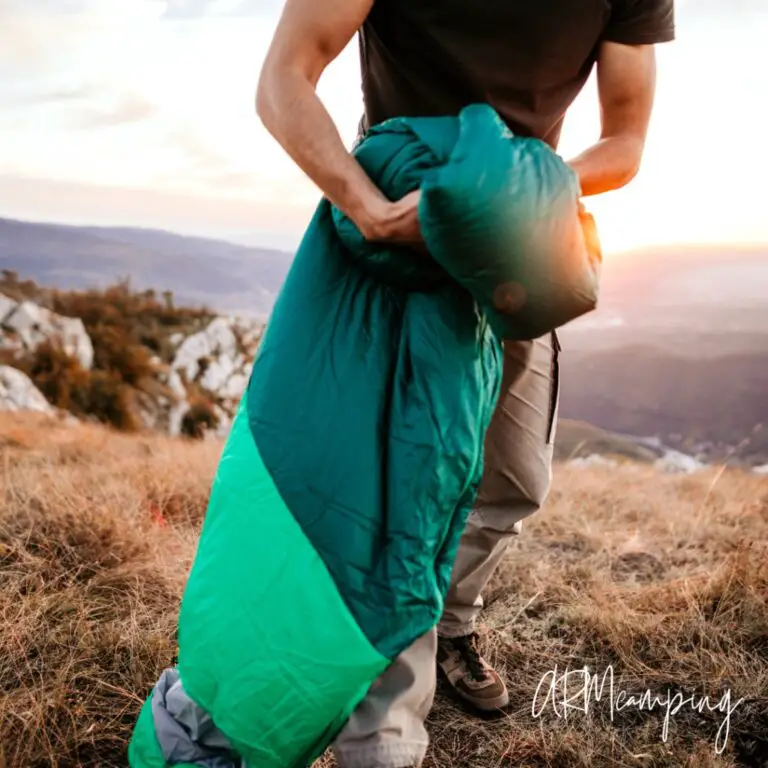
What Sleeping Bag Should I Use for Backpacking?
Table of Contents
Finding the right sleeping bag for your next backpacking adventure can be a daunting task, especially when there are so many factors that determine the right bag for you—Your size, weight, weather, sleeping position, and personal preference.
Some nights in the backcountry can be cold, others not so much. If you’re planning on being in the backcountry any night of the year, then one of the best investments you can make is a good winter sleeping bag.
The sleeping bag’s warmth depends on how insulated it is and how tightly packed its feathers are. The bag’s temperature rating will tell you how warm it will be on the coldest nights.
There are a lot of choices with backpacking sleeping bags, and the options can be overwhelming. But don’t worry: it’s actually pretty simple if you know what to look for.
There are two main factors to consider when choosing a backpacking sleeping bag: temperature rating and weight. You want to make sure you get a bag that is rated for at least 30 degrees Fahrenheit, but ideally 45 or 50 degrees.
Another key feature is an interior liner. If you’re cold or want more insulation on colder nights, this will help keep your body heat inside the bag, rather than escaping and warming up the rest of your sleeping space.
The other big factor is weight. Backpacking sleeping bags tend to be heavier than ones used in camping because they’re filled with more insulation and down instead of synthetic materials like many camping bags use. If weight isn’t an issue (and it rarely is), there are lighter options available as well — just keep in mind that they won’t be as warm or insulating either!
Before we proceed, I will recommend the “tuphen 4 Seasons Winter, Fall, Spring, Summer Sleeping Bags.” for over 5years.
So, is that all about choosing the right sleeping bag for your backpacking trip? NO! you should also consider the bag’s liner. Which led us to the next topic on this page about what you should consider before picking a backpack sleeping bag…
What to Look for In a Backpacking Sleeping Bag?
With choosing a sleeping bag, you’ve got so many options that it’s hard to know which one is right for you. The best backpacking sleeping bags are ones that keep you warm. But are they comfortable? Do they breathe? Do they, in fact, keep you warm?
1. liners
Backpacking sleeping bag liners is a great way to keep your sleeping bag clean and germ-free, without having to wash it every time you use it. They also help keep down the weight of your backpack, making it easier to carry around during long backcountry excursions.
There are several liners available on the market today, but each has its own unique characteristics that you should consider when choosing one for yourself. Below we have outlined some of the most common features that you should look for when shopping around for a good liner.
Here Are Some Things to Consider:
Sleeping bag liners can be a great way to keep your sleeping bag clean and dry at night. But what should you look for when buying a sleeping bag liner?
Durable materials: Liners made from ripstop nylon or other durable fabrics are the best choice for backpacking. These materials will last a long time and not wear out easily, which is especially important if you intend to use your liner every night.
Size: Backpacking sleeping bag liners can be as small as 3-5 ounces, so it’s best to choose one that fits in your pack. However, if you have room in your bag, then choose one that offers more warmth per ounce.
Heightened warmth: A sleeping bag liner can increase the warmth of the bag by up to 15 degrees, depending on the material. Your bag’s capabilities could be raised by up to 25 degrees with insulated liners. By enabling you to use your bag in a wider variety of settings than the temperature rating may suggest, a liner gives you adaptability in this way.
Insulation: Insulation is important for keeping your body warm at night, but also for preventing condensation from forming on you inside the bag during those cold mornings when temperatures drop below freezing. They make some liners from synthetic materials that allow moisture to escape, while they make others from cotton or wool fibers that trap moisture and prevent condensation from forming on your skin inside the bag during colder weather.
Waterproofing: While not required for sleeping bags themselves, some liners come with waterproofing treatments that make them a good choice for wet weather excursions.
Enhanced comfort: These liners have more features than just water repellency. They include insulation, temperature regulation, and even a chin guard to reduce drafts. Some also have other features like ergonomic cutouts for your hands and feet. Compared to certain sleeping bags, nylon inner liner fabrics frequently feel more comfortable against the skin. You can select the one that feels the most comfortable to you because liners come in a variety of fabrics.
Also, consider weighing…
2. Weight
When shopping for a new sleeping bag, there are several factors that you should take into consideration. With choosing a sleeping bag, you can’t just pick a brand that you like the look of; the weight also needs to be taken into consideration.
It’s not a bad idea to start with the lightest bag you can find. If you’re going to be carrying it around a lot, it may as well be lightweight. But remember, weight is a good thing with comfort and warmth, but not all of us are packing for a thru-hike or mountain climb. So this one is subjective.
If you’re comparing bags and do not know what sort of terrain you’ll be hiking, then go for the heaviest one and get used to carrying it on your back without getting too much sleep from being cold.
3. Price
The cost of a sleeping bag can vary tremendously between models with different features. For example, some bags have a built-in pillow while others don’t (or only have one).
You may think that having an extra pillow is important in order to get additional comfort while sleeping on the ground, but there are other factors at play that make this less necessary; the type of ground surface (sand or grass), how often you use your pad/mattress and how much space there is between you and your sleeping bag. If these things are important to you, then go for the cheaper model with fewer.
4. Weather
When you’re shopping for a backpacking sleeping bag, you’ll want to consider the temperature rating of your sleeping bag. This rating tells you how warm or cold your sleeping bag will be. The colder the temperature, the more insulation you’ll need to keep you warm.
There are two main categories of sleeping bags – rated for colder temperatures and rated for warmer temperatures. There are also many sub-categories within each category. For example, a 20°F sleeping bag is suitable for temperatures down to 15 degrees Fahrenheit, while an 8°F sleeping bag is suitable for temperatures up to 10 degrees Fahrenheit.
What to Look for In a Backpacking Sleeping Bag for Big Guys?
The best backpacking sleeping bags for big guys are the ones that provide warmth, comfort, and versatility. These features are essential when you go out camping because you want to enjoy your time outdoors in peace.
Sleeping bags for big men should be durable and comfortable. You don’t want to deal with a bag that is too warm or too cold. If you’re looking for a bag that will keep you warm, then look for one that has multiple layers of insulation.
This will help keep you warm even if it’s not as warm out as it could be. If you’re getting a bag that is more cold weather, friendly, then look for one with an extra zipper, so that you can regulate how much air flows through the bag when it’s not heated all the way.
Another thing to consider when buying a sleeping bag for big guys is weight and packability. You don’t want a heavy sack on your back, nor do you want something bulky that takes up space in your pack.
If possible, try finding something lightweight and compact so that it won’t weigh down your pack too much or make carrying it difficult at all times throughout the trip.
Now…
How Big Should a Sleeping Bag Be for Backpacking?
Sleeping bags come in a variety of sizes, from extra small to extra large. Normally the larger the bag, the more comfortable it will be. However, there are many other factors to consider when choosing your sleeping bag for backpacking.
The size of your sleeping bag will depend on the season you’re camping in and the climate where you’re going. They designed some bags to keep you warm down to a certain temperature, while they designed others to keep you warm when it’s cold outside but also to breathe well when it’s hot.
Generally, for backpacking and camping in the summer, a 3-season sleeping bag is a way to go. These bags offer more versatility than 2-season bags but aren’t as heavy as 4-season models.
If you’re planning on camping in winter or traveling to very cold locations, consider buying a 4-season sleeping bag that offers better insulation against extreme conditions.
Sleeping Bags and Body Size
Sleeping bags come in various sizes, which makes it easy to find one that fits your body type no matter what age or gender you are. For example:
Women are shorter than men, so they’ll want a shorter-length bag with less insulation in the foot area (because they sleep with their feet closer together).
Children should use a smaller-sized sleeping bag because they won’t fit into adult-sized models very well at all (unless they are unusually tall for their age).
The most common sleeping bags come in three sizes: extra small (less than 5’5″), small (5’5″ to 6’2″), and medium (6’2″ to 6’8″). You can also find larger bags designed specifically for tall people or those who like an extra room inside of their sleeping bags. These may cost more money than standard-sized models, but if you fall into either category, it might be worth the additional cost.
Here’s how To Choose Your Bag Size Based on Your Height and Weight:
Width: The width of the bag should be enough so that you can sleep comfortably without feeling crushed. If you’re tall, choose a wide sleeping bag; if you’re short, get a narrow one.
Length: The length of the sleeping bag should be long enough for you to stretch out without touching the ground or your tent walls. Some people like to use the “finger test” — make sure that you have enough room to extend both arms straight out from your sides, hitting nothing (like a tent wall). If you’re tall, get a longer sleeping bag; if you’re short, get a shorter one.
Fill Weight: You’ll find this number listed as fill down (ranging from 550-fill down up to 950-fill down) for most backpacking bags.
How Light Should My Backpacking Sleeping Bag Be
The weight of a sleeping bag is important for many reasons. The most obvious reason is that heavier bags are more difficult to carry. However, there are several other factors to consider when choosing a backpacking sleeping bag.
The temperature rating of your bag can be a great indicator of how lightweight you should go. If you plan on spending lots of time above treeline or at high altitudes in the winter, then you will need something more substantial than if you are hiking year-round in places like the Pacific Northwest where summer nights can still get chilly. It’s more important to have enough insulation than it is to have a super-lightweight bag (depending on what season you’re camping).
Another factor that affects the weight of your sleeping bag is its fill type — down or synthetic? Down is lighter and compresses better, but also costs more than synthetic materials.
Synthetic materials are typically cheaper and less durable, but also hold up better in wet conditions such as rain or snow (which brings us back around to our first point about temperature ratings).






